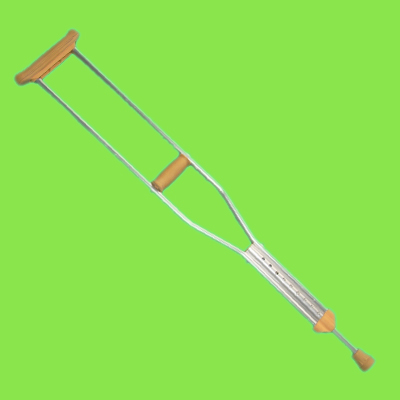Did you ever have a broken leg?
你曾经有过一条腿骨折吗?
Or did you ever see someone else in a cast?
或是你曾经看到过别人腿上裹着石膏吗?
If so, you may have noticed something odd whenthe crutchescome out.
如果有的话,你会发现拄着拐杖时,会有奇怪的事发生。
You would think that person would be the slowest in the crowd,just hobbling along.
你会认为那个拄着拐杖的人应该是人群中走得最慢的,因为他们步履蹒跚。
But that is not so.
但事实并非如此。
Once someone becomes comfortable moving around on crutches, they can often move very quickly, even outpacing uninjured folks.
当一个人习惯了用拐杖走路以后,他们就可以移动的很快,甚至超过没有受伤的人。
What's going onhere?
这是为什么呢?
The answer is found in the dynamics of walking. Ask yourself the following question:
我们可以在走路的动力学中发现答案。问问你自己以下问题:

who can walkfaster, a ballet dancer whose leg muscles are extremely fit, or a couch potato whose legs aresoft and flabby?
谁可以走得更快?是腿部肌肉非常健壮的芭蕾舞演员,还是腿部柔软松弛,整天坐着看电视的人?
We're not talking about running now, just about walking.
我们不是说跑步,只是走路。
The answer? Whichever one is taller.
答案是?谁更高就走得更快。
Yep. Leaving aside issues such as weak knees and just speaking in general, muscular ability doesnot determine walking speed.
是的。撇开膝关节疲软不说,就一般来讲的话,肌肉的能力并不能决定走路的速度,
It's the length of the leg that does it.
但腿的长度可以。
Little children have to run tokeep pace with a walking adult not because their muscles are weak but because their legs areshort.
小孩子要跑步才能跟上大人的步伐,并不是因为他们的肌肉不够发达,而是他们的腿太短了。
Now, let's think about the person with the broken leg.
现在我们来看看骨折的腿。
True, one leg is out of commission and there's the extra weight of the cast.
的确,一条腿不能发挥作用了,并且还有额外石膏的重量。
But if you watch a person on crutches walk, you'll notice thatthey keep both legs together with their torso and pivot from the shoulder.
但是如果你看到一个人拄着拐杖走路,你会发现他们的双腿总是与身体和肩部的支点保持一致的。
The body swings forward as the crutches lean back, and vice versa.
当拐杖向后靠时身体就向前摆动,反之亦然。
That way they canmove as if the majority of their body were two gigantic legs.
这就是为什么他们可以走动,因为他们大部份的身体就像两条巨大的腿。
Their stride effectively becomes thatof someone about twice their actual height.
他们走路的速度可以和比他们高两倍的人相提并论。












